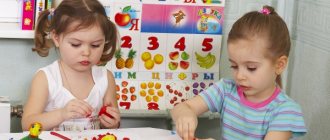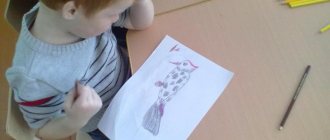What is needed for creativity in kindergarten?
When getting the baby ready for kindergarten, mothers often wonder: what should the child buy for creative activities? Usually in kindergartens, the teacher gives parents a standard “portfolio” to purchase - pencils, paints, brushes, sketchbooks, plasticine, colored paper, glue.
The set is, of course, understandable. But what type of plasticine should you prefer, what pencils should you buy – thick or thin, etc.? Mommy has a lot of questions like this. Let's try to highlight some of them.
For drawing
It is recommended to buy thicker pencils This diameter is much more convenient for children to hold in their hands. In addition, these pencils must be triangular. This structure will not allow the hand to strain, and the baby will learn to hold a pencil in his hand correctly. To practice drawing in kindergarten, you need colored pencils consisting of at least six primary colors. Now there is a huge selection of pencils from different manufacturers. Don’t chase beautiful packaging and don’t buy overly expensive stationery. After all, all the pencils in the kindergarten end up in a “common pot.”
The child will draw not only with pencils, but also with felt-tip pens . What little one doesn't like to run them across paper? The lines are straight, no effort is needed, the colors are bright. Isn't it beauty? When choosing felt-tip pens, give preference to those that do not have a pronounced odor, preferably water-based with the addition of food coloring. The youngest artists can draw not only on paper, but also on clothes and hands. Therefore, you should buy those that can be washed or washed easily. Many children love to open the caps on felt-tip pens. It's a pity that they just dry out quickly because of this. No problem! Buy “non-drying” triangular markers - they can remain open for a long time.
Paints are especially popular among children. Most often, gouache is used in kindergarten. It is convenient to draw on paper, it is easy to apply, does not spread, dries well, and is easily washed off your hands. It is advisable to buy a palette of 8-10 colors. The child gets acquainted with additional shades and learns to mix paints. All paints should have expiration date information on the back. Check it out as old paint doesn't mix well with water. brushes for painting: one thick, two thinner. Test them for softness. All fibers must be smooth and soft in order to draw evenly.
albums from white thick paper. Children love to draw (rub) in one place. And if the paper is thin, then the probability of a hole occurring is one hundred percent. Number of pages – at least 20 sheets.
For sculpting
You can find many materials for modeling in the store. But in kindergarten they prefer to sculpt from plasticine. There are several types of plasticine - wheat flour based, paraffin, wax, etc. It’s good when the plasticine is not greasy and kneads easily. But often this type dries out when it has been left unharvested for some time. It is not suitable for kindergarten. It’s better to buy the usual one in blocks of 6-8 colors, so that the baby can crush yesterday’s masterpiece displayed for mom and make a new one. Read on the box to ensure that the plasticine contains natural ingredients.
We make applications
For applications, children will need various papers - colored, velvet, cardboard. When buying sets, make sure that they contain at least 6 A4 colors. It is more convenient to glue with a glue stick: the child will not get dirty and will not spill it. Already in older groups, children are introduced to liquid stationery glue. To cut out for crafts, the baby will need scissors. Usually in kindergartens children in the older group are allowed to cut out parts on their own. Scissors must have rounded ends and be closed with a special housing.
Non-traditional drawing techniques for preschool children
Consultation for parents “Non-traditional drawing techniques in joint activities of children and parents”
Unconventional drawing techniques in the joint activities of children and parents
Author: Toporkova Natalya Yuryevna The artist wants to draw, Let them not give him a notebook... That’s why the artist and the artist - He draws wherever he can... He draws with a stick on the ground, In winter, with his finger on the glass, and writes charcoal on the fence, and on the wallpaper in the hallway. He draws with chalk on a board, writes on clay and sand, even if there is no paper at hand, and no money for canvases, he will draw on stone, and on a piece of birch bark. He will paint the air with fireworks, Taking a pitchfork, he writes on the water, An artist, because he is an artist, Because he can draw everywhere. And whoever interferes with the artist deprives the earth of its beauty! “The origins of children’s abilities and talents are at their fingertips.
From the fingers, figuratively speaking, come the finest threads - streams that feed the source of creative thought. In other words, the more skill in a child’s hand, the smarter the child.” V.A. Sukhomlinsky It is known that drawing is one of the most favorite children’s activities, which develops in a child many positive qualities, such as perseverance and patience, attentiveness, imagination, ability to think and much more.
All of them will be very useful to the baby in later life. Along with traditional methods of depicting an object or object on paper (drawing with pencils, brushes and paints, gouache), I also use non-traditional techniques in my work. I think that they attract the attention of little fidgets more. They are interesting to children of all ages and allow them to reach their full potential during the creative process. The work of creating drawings is not difficult, so kids do it with pleasure, acquiring skills in working with materials and becoming familiar with painting. To instill a love of fine art and arouse interest in drawing, starting from a young age, I advise parents to use unconventional methods of depiction. Such unconventional drawing gives children a lot of positive emotions, reveals the possibility of using objects well known to them as artistic materials, and surprises them with their unpredictability. Organize your workspace at home so that your child can comfortably not only sit, but also stand and sometimes move around a piece of paper. After all, you can draw any way, anywhere and with anything! Be friends with your child. Try to understand what makes him happy, what makes him sad, what he strives for. Ask him to tell you what he wanted to depict. And do not forget that the child expects praise from you. He really wants you, adults, to like his work. Rejoice at his successes and under no circumstances ridicule the young artist if he fails. No problem next time! Non-traditional drawing techniques are methods of drawing with various materials: foam rubber, crumpled paper, tubes, threads, paraffin candles, dry leaves; drawing with palms, fingers, blunt ends of pencils, cotton swabs, etc. They are different for each age group. With children of primary preschool age you can use: • finger painting • painting with cotton swabs • poking with a hard semi-dry brush • painting with palms Children of middle preschool age can be introduced to more complex techniques: • foam rubber imprinting • stencil printing • candle and watercolor • spraying • poking B In older preschool age, children can master even more difficult methods and techniques: • regular blotography • drawing with a toothpick • monotype • batik Each of these methods is a small game. Their use allows children to feel more relaxed, bolder, develops imagination and freedom for self-expression, and the work also contributes to the development of coordination of movements. Non-traditional artistic and graphic techniques: Stamping Since little children are always happy to stamp everything they can, they always like this drawing technique. Using a pre-made stamp (this could be the bottom of a plastic bottle, a lid, a cut from a potato, an apple, etc., covered with paint), prints are made on paper, creating a design that can later be supplemented. "Leaf Printing" - uses different leaves from different trees. They are covered with paint using a brush, leaving no empty spaces; this is done on a separate sheet of paper. Then the painted side is pressed tightly against the paper, trying not to move it out of place. The leaves can be reused by applying a different color to it; when mixing paints, an unusual shade can be obtained; the rest is painted on with a brush. The results are magnificent landscapes.
“Drawing with the palm or fingers” The child dips his palm (the entire brush) into gouache or paints it with a brush (from the age of five) and makes an imprint on paper. They draw with both the right and left hands, painted in different colors. After work, wipe your hands with a napkin, then the gouache is easily washed off.
“Imprint with crumpled paper” The child crumples the paper in his hands until it becomes soft. Then he rolls it into a ball. Its dimensions may vary. After this, the child presses the crumpled paper to a stamp pad with paint and makes an impression on the paper. “Paper rolling” - take paper and crumple it in your hands until it becomes soft. Then a ball is rolled out of it. The sizes can be different (small is a berry, large is a snowman). After this, the paper ball is dipped in glue and glued to the base.
“Drawing with cotton swabs” It’s very easy to draw with cotton swabs. We dip the stick in water, then in paint and put dots on the sheet. What to draw? Whatever! The sky and the sun, a house in the village, a river, cars, dolls. The main thing in this matter is desire!
"Drawing on wet paper." The sheet is moistened with water, and then the image is applied with a brush or finger. It will turn out to be blurry in the rain or fog. If you need to draw details, you need to wait until the drawing dries or put thick paint on the brush. “Drawing with a toothbrush and disposable forks” The brush and fork are dipped in paint and an imprint is made on paper. You can drag a brush over a sheet, you will get waves, wind, stream, etc.
“Blotography” Blot is an integral part of every child. Therefore, this technique is very close in spirit to children. To work you need paper, a brush and paints. Paint is drawn onto the brush and dripped from a height onto the paper. By turning the sheet or blowing on it, the blot blurs, forming an interesting image.
“Plasticineography” - plasticine must be heated (can be in a container with hot water). Cardboard is used, and plasticine is fixed to the surface with a pre-drawn background and outline using the technique of pressing and flattening.
“Drawing with Soap Bubbles” Soap bubbles are a well-known children's pastime. Fragile, transparent, they shimmer so beautifully with different colors of the rainbow and create a feeling of celebration. And you can also draw with them. Drawings using this unusual technique also turn out to be very unusual, and the activity brings joy to children. Plus, the prints turn out different every time, so it's very interesting to experiment with them and then imagine what they look like.
“Nitcography” There are two options for working with this technique. For each of them you will need paints with a brush, a container for them, threads and paper. In the first case, paint of any color you like is applied to the thread. The paper needs to be folded in half. The colored thread is laid out on one side, and the other is covered. The thread is then pulled out. When a child unfolds a piece of paper, there is some image there, which he can then complete at his own discretion. The second method also involves using glue. The drawing is created by gluing threads to paper in the form of a particular object.
“Batik” Batik is a very old drawing technique. At the same time, the fabric is painted. The design is applied to the fabric using special paints.
Drawing with an unconventional technique: • - helps relieve children's fears; • — develops self-confidence; • — develops spatial thinking; • — teaches children to freely express their ideas; • — encourages children to creative searches and solutions; • — teaches children to work with a variety of materials; • - develops a sense of composition, rhythm, color - perception; • — develops fine motor skills of the hands; • — develops creativity, imagination and flight of fancy; • — while working, children receive aesthetic pleasure. Non-traditional drawing allows you to reveal the creative potential of the child; gradually increase interest in artistic activity, develop mental processes. It allows children to feel more relaxed, bolder, develops imagination, and gives complete freedom for self-expression. Tips for parents: materials (pencils, paints, brushes, felt-tip pens, wax crayons, etc.) must be placed in the baby’s field of vision so that he has a desire to create; introduce him to the surrounding world of things, living and inanimate nature, objects of fine art, offer to draw everything that the child likes to talk about, and talk with him about everything that he likes to draw; do not criticize the child and do not rush; on the contrary, from time to time encourage the child to practice drawing; praise your child, help him, trust him, because your child is individual!
We recommend watching:
Unconventional drawing technique pointillism
Drawing lesson in the middle group of kindergarten Drawing with a candle in kindergarten
Drawing on sandpaper
Similar articles:
Fine arts lesson for the senior group
Monotype in kindergarten
Non-traditional drawing techniques in preschool educational institutions
Non-traditional drawing technique in kindergarten. Passepartout
Wax painting in kindergarten






